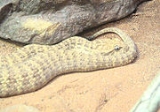
Desert Death Adder
Encyclopedia
The Desert Death Adder, Acanthophis pyrrhus, is a species of snake
native to Australia
and is one of the most venomous land snakes in the world. The Desert Death Adder is under threat due to the destruction of habitat.
genus, highly venomous elapids with short and thick bodies, triangular heads, mobile fangs, and a thin tapering tail. They grow to lengths up to 70 centimeters, with a snout to vent length of 62 cm, and have a flattened appearance. Desert Death Adders are coloured brick-red, or yellow-reddish, with strong or inconspicuous yellow bands which are camouflaged with their surroundings. The tail tip is used as a lure to attract potential prey and is distinctively darker in colour. Their fangs are longer than most of Australia’s venomous snakes.
The species was first described in 1898 by George Albert Boulenger
.
, to central regions as far south as Kalgoorlie and into the Northern Territory
. The related species, the Common or Southern Death Adder, is found in a different range.
Desert Death Adders are found in living in remote areas, amongst porcupine grass, stony flats, sandy ridges and rocky outcrops of Central and Western Australia. In southwest Australia they occur in hummock grass in mallee.
They are usually most active after dark, only occasionally being seen during the day. They may climb shrubs or grasses to bask in the morning, and are seen on roads near outlying urban areas.
Desert Death Adders feed on lizards, especially skinks and dragons, and small mammals. They are attracted to the snake, which may lie in a patient ambush for days, by the wiggling of the lure at the tip of the tail like its sister, the Common Death Adder
. When moved it bears a striking resemblance to a worm or caterpillar and is thus a tempting morsel for a passing lizard.
Snake
Snakes are elongate, legless, carnivorous reptiles of the suborder Serpentes that can be distinguished from legless lizards by their lack of eyelids and external ears. Like all squamates, snakes are ectothermic, amniote vertebrates covered in overlapping scales...
native to Australia
Australia
Australia , officially the Commonwealth of Australia, is a country in the Southern Hemisphere comprising the mainland of the Australian continent, the island of Tasmania, and numerous smaller islands in the Indian and Pacific Oceans. It is the world's sixth-largest country by total area...
and is one of the most venomous land snakes in the world. The Desert Death Adder is under threat due to the destruction of habitat.
Description
Desert Death Adders are members of the AcanthophisAcanthophis
Acanthophis is a genus of elapid snakes. Commonly called death adders, they are native to Australia, New Guinea and nearby islands, and are among the most venomous snakes in the world...
genus, highly venomous elapids with short and thick bodies, triangular heads, mobile fangs, and a thin tapering tail. They grow to lengths up to 70 centimeters, with a snout to vent length of 62 cm, and have a flattened appearance. Desert Death Adders are coloured brick-red, or yellow-reddish, with strong or inconspicuous yellow bands which are camouflaged with their surroundings. The tail tip is used as a lure to attract potential prey and is distinctively darker in colour. Their fangs are longer than most of Australia’s venomous snakes.
The species was first described in 1898 by George Albert Boulenger
George Albert Boulenger
George Albert Boulenger FRS was a Belgian-British zoologist who identified over 2000 new animal species, chiefly fish, reptiles and amphibians.-Life:...
.
Distribution
The Desert Death Adder occurs from the coast of Western AustraliaWestern Australia
Western Australia is a state of Australia, occupying the entire western third of the Australian continent. It is bounded by the Indian Ocean to the north and west, the Great Australian Bight and Indian Ocean to the south, the Northern Territory to the north-east and South Australia to the south-east...
, to central regions as far south as Kalgoorlie and into the Northern Territory
Northern Territory
The Northern Territory is a federal territory of Australia, occupying much of the centre of the mainland continent, as well as the central northern regions...
. The related species, the Common or Southern Death Adder, is found in a different range.
Desert Death Adders are found in living in remote areas, amongst porcupine grass, stony flats, sandy ridges and rocky outcrops of Central and Western Australia. In southwest Australia they occur in hummock grass in mallee.
Behaviour
The desert death adder only bites if the threat is very close to them. They also use their bite to catch their prey. They only bite when they are close to their target.They are usually most active after dark, only occasionally being seen during the day. They may climb shrubs or grasses to bask in the morning, and are seen on roads near outlying urban areas.
Desert Death Adders feed on lizards, especially skinks and dragons, and small mammals. They are attracted to the snake, which may lie in a patient ambush for days, by the wiggling of the lure at the tip of the tail like its sister, the Common Death Adder
Common Death Adder
The Common Death Adder , is a species of Death Adder native to Australia. It is one of the most venomous land snakes in Australia and the world. Unlike its sister species of Death Adders, the Common Death Adder is common and is not under major threat.-Description:Common Death Adders have broad...
. When moved it bears a striking resemblance to a worm or caterpillar and is thus a tempting morsel for a passing lizard.

